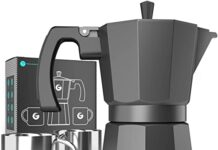Today, we’re here to unravel the mystery behind the Bialetti Moka pot – that iconic Italian coffee maker that has taken the world by storm. If you’ve ever wondered how this little beauty of a device manages to create that rich, flavorful, and aromatic cup of coffee, you’re about to find out! So sit back, grab a cup of your favorite brew, and join us as we embark on a delightful journey into the inner workings of the Bialetti Moka pot.
The Bialetti Moka Pot
Design and Components
The Bialetti Moka Pot is a classic Italian coffee maker that has become an icon in the coffee world. It is known for its unique design and the rich, flavorful coffee it produces. Let’s take a closer look at its design and the components that make up this popular brewing device.
The Moka Pot Structure
The Moka Pot consists of three main parts: the bottom chamber, the filter funnel, and the top chamber. These parts are made of durable aluminum, which helps to distribute heat evenly during the brewing process. The Moka Pot also features a sturdy handle and a lid to ensure safe handling and prevent any potential accidents.
The Filter Funnel
The filter funnel is where the ground coffee is placed. This funnel has small perforations that allow water to pass through while retaining the coffee grounds. It is important to use a medium-coarse grind in order to achieve the best results. The filter funnel is designed to create a pressure build-up, which forces the water to pass through the coffee grounds, extracting the flavors and aromas.
The Water Chamber
The water chamber is located at the bottom of the Moka Pot. This is where you pour cold water before brewing your coffee. The water chamber has a pressure valve that allows excess steam to escape during the brewing process. It is crucial to fill the water chamber up to the marked level to ensure proper brewing.
The Upper Chamber
The upper chamber is where the brewed coffee collects. This chamber has a spout that allows you to pour the coffee into your mug or cup. The upper chamber also has a gasket that creates a tight seal between the upper and bottom chambers, preventing any leaks during the brewing process.
The Safety Valve
The safety valve is a vital component of the Moka Pot. It is located on the side of the bottom chamber and ensures that pressure does not build up to dangerous levels during brewing. If the pressure becomes too high, the safety valve will release the excess steam, preventing any potential accidents or damage to the Moka Pot.
The Screw Base
The screw base is located at the bottom of the Moka Pot and holds all the components together. It is important to ensure that the screw base is securely tightened before brewing to avoid any leaks or accidents. The screw base also acts as a heat conductor, allowing the Moka Pot to heat evenly during the brewing process.
The Moka Pot Brewing Process
Now that we are familiar with the design and components of the Bialetti Moka Pot, let’s explore the brewing process that this coffee maker offers. The Moka Pot is known for its simplicity and ability to produce a strong and flavorful cup of coffee.
Grinding the Coffee Beans
The first step in brewing coffee with a Moka Pot is to grind the coffee beans to a medium-coarse consistency. This ensures optimal extraction during the brewing process. It is recommended to use freshly roasted beans for the best flavor. Once the coffee beans are ground, it’s time to move on to the next step.
Adding Water to the Moka Pot
The next step is to add cold water to the water chamber of the Moka Pot. It is essential to fill the water chamber up to the marked level, avoiding any overfilling. The water chamber should not be overfilled as it may lead to unsafe pressure build-up during brewing.
Assembling the Moka Pot
Once the water is added, it’s time to assemble the Moka Pot. Start by placing the filter funnel on top of the water chamber. Fill the filter funnel with ground coffee and make sure it is evenly distributed. Carefully screw the upper chamber onto the water chamber, ensuring a tight seal. Double-check that all the components are securely assembled before proceeding.
Placing the Moka Pot on Heat
Now that the Moka Pot is fully assembled, it’s time to place it on a heat source. Ensure that the heat source is set to medium-low to prevent overheating. It is also important to use a heat source that matches the size of the Moka Pot to prevent any potential accidents. The aluminum construction of the Moka Pot allows for efficient heat distribution, resulting in a smooth brewing process.
Brewing and Extracting the Coffee
As the Moka Pot starts heating up, the water in the lower chamber will begin to boil and create steam. The steam will travel through the filter funnel, passing through the coffee grounds, and upward into the upper chamber. This process creates pressure, forcing the water to extract the flavors and aromas from the coffee grounds.
Once the coffee starts to pour into the upper chamber, it is important to pay attention to the brewing process. The Moka Pot is designed to make a distinctive gurgling sound when the brewing process is complete. This sound indicates that all the water has passed through the coffee grounds.
Safety Precautions
While the Bialetti Moka Pot offers a simple and enjoyable brewing process, it is important to take certain safety precautions to ensure a safe and pleasant coffee experience.
Use in a Well-Ventilated Area
When using a Moka Pot, it is recommended to do so in a well-ventilated area. The brewing process can produce steam and slight odors, which may be uncomfortable in a confined space. Proper ventilation ensures a pleasant brewing experience and minimizes the risk of heat-related accidents.
Avoid Overheating
To prevent any accidents or damage to the Moka Pot, it is essential to avoid overheating. Using a medium-low heat source is recommended. Overheating can cause excessive pressure build-up and may lead to the safety valve being triggered, resulting in potential spills or burns.
Handling the Hot Moka Pot
After the brewing process is complete, it is important to handle the hot Moka Pot with caution. The aluminum construction retains heat, making the Moka Pot hot to the touch. Always use oven mitts or a towel to handle the Moka Pot and avoid contact with hot surfaces. It is also recommended to allow the Moka Pot to cool down before disassembling or cleaning.
Cleaning and Maintenance
To ensure the longevity of your Bialetti Moka Pot and to maintain its performance, regular cleaning and maintenance are necessary.
Disassembling the Moka Pot
Before cleaning, it is important to disassemble the Moka Pot. Unscrew the upper chamber from the water chamber and remove the filter funnel. Carefully separate all the components to clean them individually.
Cleaning the Various Components
The Moka Pot components can be cleaned using warm water and mild dish soap. Avoid using abrasive cleaners or harsh chemicals, as they may damage the aluminum surfaces. Gently scrub the parts with a soft brush or sponge to remove any coffee residue or stains. Rinse thoroughly and dry completely before reassembling.
Removing Coffee Stains
Over time, coffee stains may develop on the Moka Pot’s aluminum surface. To remove these stains, you can use a mixture of equal parts vinegar and water. Apply the mixture to the stained areas using a cloth or sponge and gently scrub. Rinse thoroughly and dry completely before using the Moka Pot.
Replacing Worn Parts
With regular use, certain parts of the Moka Pot may wear out over time. The gasket, safety valve, and filter funnel are commonly replaced components. It is recommended to check these parts periodically and replace them as needed to ensure the optimal performance of your Moka Pot.
In conclusion, the Bialetti Moka Pot is a classic and reliable coffee maker known for its unique design and flavorful coffee. By understanding its design and components, as well as following the brewing process, safety precautions, and cleaning procedures, you can experience the joy of brewing your own delicious cup of coffee with the Bialetti Moka Pot.



































